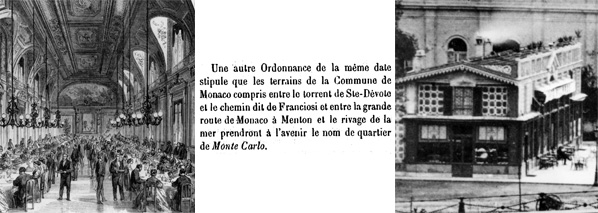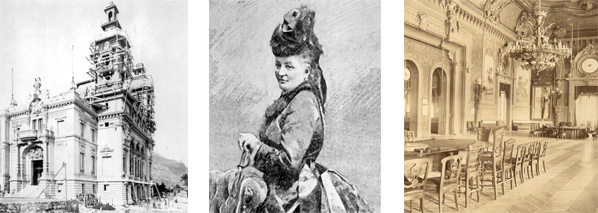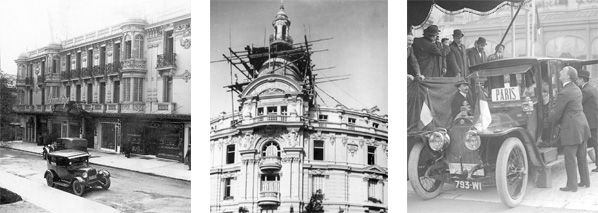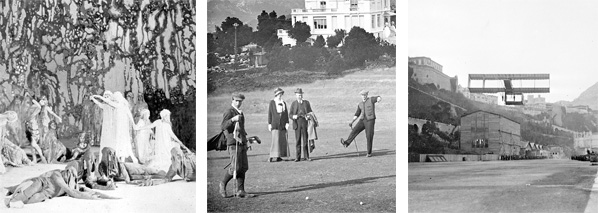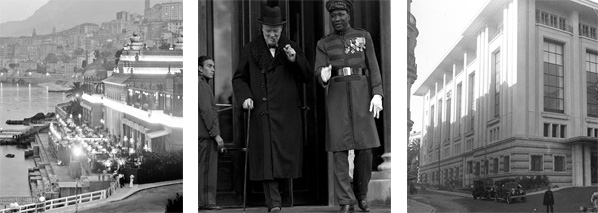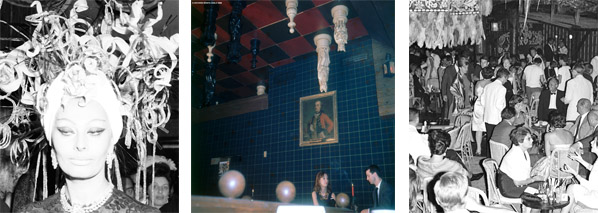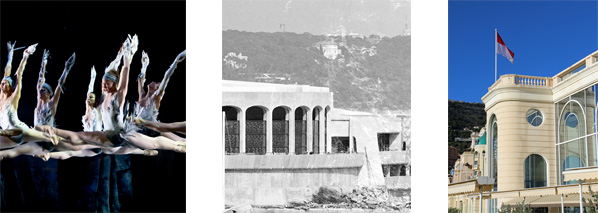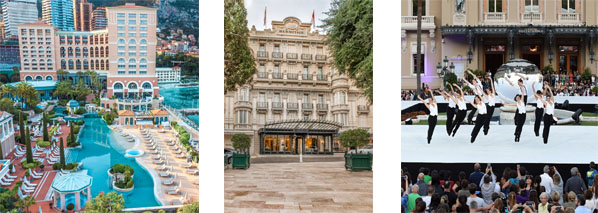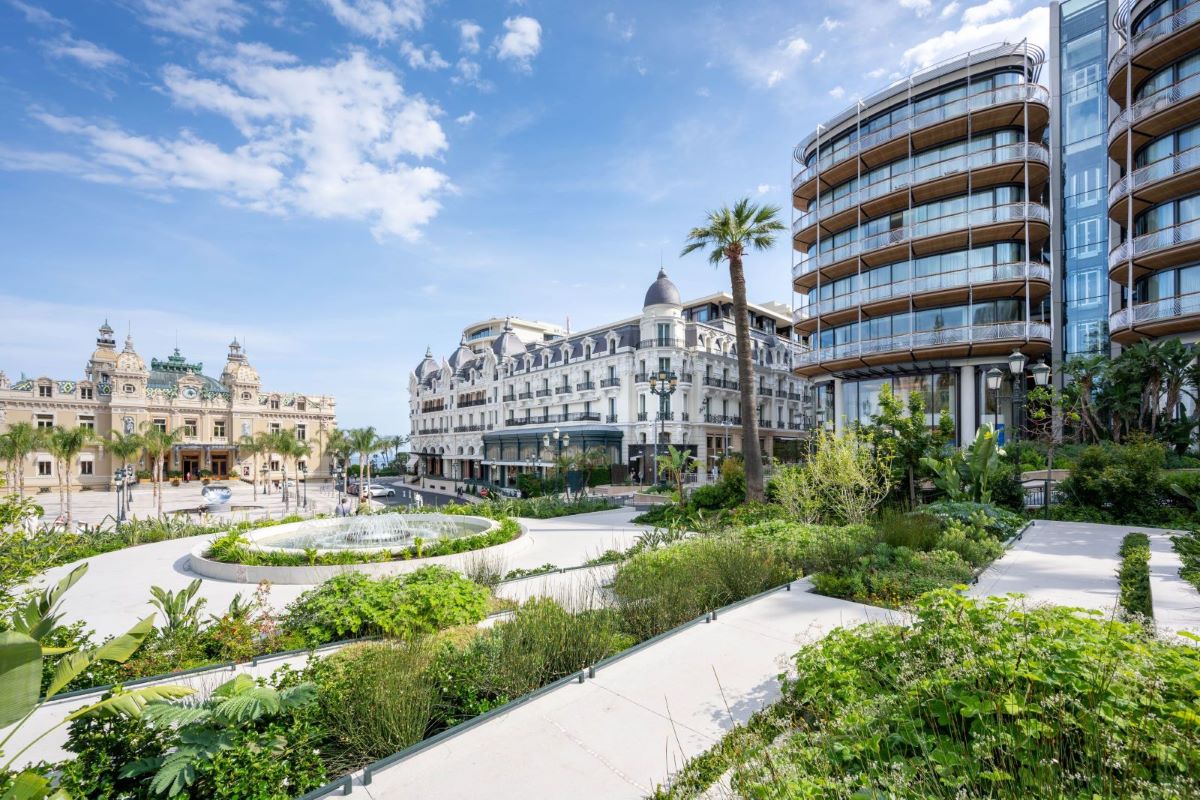
History
The history of Monte-Carlo Société des Bains de Mer and that of Monaco are intricately linked. Founded in 1863 by Royal Decree of Prince Charles III, this extraordinary company participated in the birth of Monte Carlo and its first glory days. Since its creation, Société des Bains de Mer has always played a key role in Monaco, adapting to modernity and predicting new trends.
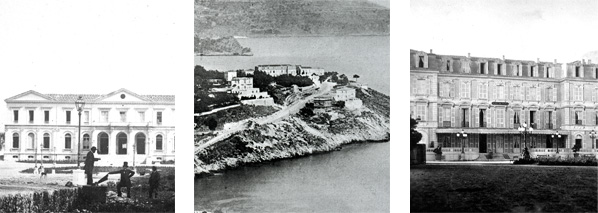
The creation of Monte-Carlo: 1863-1866
In 1863, the Plateau des Spélugues on which the Casino was built was nothing more than arid land used to cultivate typical Mediterranean plant species: olive, citrus and orange trees.
It was Prince Charles III, successor to Prince Florestan I, who initiated the creation of a new quarter in Monaco. The press at the time noted the Prince's aim for the town: ‘The new Société des Bains de Mer Casino will soon rise up on a monumental scale. Around the Casino, beautiful hotels will be built that will have nothing to fear from comparisons with those in Paris, London and New York’. Five years after the first stone was laid, the Casino opened in spring 1863. It went on to be a huge success.
François Blanc was the man for the job. He came from Homburg, a German spa town whose prosperity he had assured. He owned Société des Bains de Mer and Cercle des Etrangers à Monaco for 50 years. In line with the Prince’s wishes, he continued to reinforce the principles of the creation of Monte Carlo: an exceptional place due to its luxury, comfort and location.
In addition to the Casino, Hôtel de Paris and Café de Paris, superb gardens and villas soon transformed the Plateau des Spélugues into a real town that needed a name. Prince Charles III decreed on 1st June 1866 that the facilities of the Société des Bains de Mer would henceforth be called ‘Monte Carlo’.
Monte-Carlo in vogue: 1866-1870
François Blanc and his wife Marie built the most famous hotel in Monaco: the Hôtel de Paris.
The most talented designers in France and worldwide were carefully selected to ensure the best result.
To satisfy an ever-growing customer base, François Blanc decided to build the first extension of the hotel, just two years after it opened. From January 1866, the first customers of the new dining room were dazzled by the building designed by the architect Godinot de la Bretonnerie, and discovered gas lighting produced by the new factory in Monaco.
Construction in Monte Carlo was stepped up: the predecessor to the Café de Paris opened to the public in 1868, completing the ‘magic triangle’ of the Place du Casino. Although modest in size, the establishment called Café Divan was one of the most popular places for discussion, entertainment and relaxation. Even then, the building was home to a café, a restaurant, a jeweller’s and a tobacconist's.
The newly christened Monte Carlo was a huge success. In 1869, more than 170,000 tourists visited.
The clientele was elite: the fact that the Prince of Wales, the future Edward VII, Alexandre Dumas, Jacques Offenbach, Baron Haussmann and Prince Napoleon all stayed there is testament to Monaco's excellent reputation. Winter was celebrated as the favourite season by tourists attracted to the mild climate.
Monaco's local newspaper noted that ‘Monaco ranks among the top winter resorts’. Monte Carlo was in vogue and a meeting place for high society.
Major construction work: 1870-1890
When François Blanc died in 1877, his wife Marie took over the management of Société des Bains de Mer. She continued her husband's work and decided to build new wine cellars at the Hôtel de Paris, dedicated to fine wine.
The old buildings of the Casino were torn down in 1878 to make way, in less than 6 months, for the construction of a new complex. Gambling was temporarily moved to the Hôtel de Paris. After building the Paris Opera House, Charles Garnier was to take the lead on the construction of the Casino’s theatre and large gaming room.
He gave the building its current appearance by crowning it with a dome and two pinnacles.
Sarah Bernhardt was the first to star at the Opera House when she performed there for opening night on 25 January 1879.
In the same year, the architect Dutrou built the Casino's remarkable atrium, with twenty-eight stucco-topped stone columns supporting a gallery lit up by splendid bronze candelabra.
Marie Blanc produced high-quality shows and hosted the most famous performers. When she died in 1881, the Hôtel de Paris and Casino were world renowned as the liveliest and most attractive luxury resort venues.
The Casino was so successful that it had to continually be made bigger. In 1881, Charles Garnier built the current Salle des Amériques. In 1890, Jules Touzet designed two additional rooms.

Monte-Carlo and technical innovations: 1882-1897
In 1882, the Café Divan gave way to the Café de Paris. The original modest building was replaced in spring 1897 by a magnificent Moorish-style building.
In the same year, crowds gathered on the Place to see one of the most famous visitors to the Café de Paris: André Michelin, who lost control of his car during the Marseille-Fréjus-Monte-Carlo race and ended up crashing into one of the café’s pillars. Luckily, nobody was hurt in the accident.
At the end of the 19th century, Monte Carlo, an undisputed leader in entertainment, presented technical innovations that amazed the public. The basements of the Casino were even used for science, specifically by one of its great men, Gramme. The inventor's assignment was to perfect his famous rotating machine to produce electricity and make Monte Carlo the first town with electric lighting. A fire forced the Casino's management to put a stop to the inventor's research, but it was thanks to the work he carried out in Monaco that he finally perfected his famous generator.
In September 1897, Société des Bains de Mer organised film and photography competitions. Conferences held at the Palais des Beaux-Arts presented the physical properties of X-rays. But Monte Carlo's real passion for technical advances gradually focused on one subject: cars. The motorboat competitions held at the end of the 19th century had helped to improve combustion engine technology, so it was only natural that cars found a home in Monte Carlo.
Monte-Carlo in the 20th century
In 1900, the modest Hôtel Hermitage was transformed into a luxury resort residence. Its belle époque dining room was designed by Rome Prize winner and 1889 World Fair gold medallist Gabriel Ferrier. It has magnificent frescoes reminiscent of the paintings of Fragonard and Boucher. The structure of the glass roof of the conservatory was designed by Eiffel School, from Gustave Eiffel workshops, father of the tower in Paris that bears his name.
In the same period, the Hôtel de Paris was extended with a new wing, the famous ‘Rotonde’. Originally topped by a dome engraved with the arms of the city of Paris, the height of the Rotonde was increased twice. The increase in hotel capacity was due to the growth of the Casino’s customer base. The Salle Blanche, a conversation lounge designed by Schmit, was opened to the public in 1904. The most surprising decorative element is still the famous painting by Gervais of the ‘Florentine Graces’. Visitors were surprised at the resemblance of these three figures to the highly sought-after Cléo de Mérode, Liane de Pougy and La Belle Otéro.
Monte Carlo became more urban to satisfy its customer base. Monaco’s roads were the first to be paved for luxury cars, which were already taking part in Concours d’Elegance competitions at the beginning of the century.
In 1911, the tradition of the Monte Carlo Rallies was born, the first of which was won by the pilot Rougier.
Monte-Carlo in the Belle Epoque: 1911-1914
The year 1911 saw the arrival of Diaghilev at the Monte Carlo Opera House. After the success in Paris of the Ballets Russes from 1907-1910, he expressed his intention to direct his own ballet company and Monte Carlo gave him that opportunity. Guided by his instincts, he surrounded himself with a troupe of 80 performers, including the famous Nijinsky, Lifar and Fokine. Some of his ballets were worldwide successes: Le Spectre de la Rose, Narcisse and Les Papillons. The sets for these ballets were designed by Picasso, Matisse and Braque. Diaghilev got Jean Cocteau to design the poster for the first performance by Ballets Russes in 1911.
The Café de Paris was a meeting place for performers. Diaghilev’s troupe had dinner there every night after their shows. The year 1911 was also a memorable year for Monaco with the opening on Mont Agel of the Monte Carlo Golf Club, to the delight of the large British community present at the time. From the top (900 metres), the view of the sea and Monaco was breathtaking.
At the beginning of the century, novelty came from the air with the pilot Rougier, who flew his aeroplane off the coast of the Bay of Hercules and over the Tête de Chien, the impressive rock promontory overlooking Monaco.
The year 1912 saw the first aerial photograph of Monaco taken by Renaux and the first seaplane in the world presented in the port of Monaco by Fabre. Speed is celebrated in Monaco. Le Figaro chose to sing the praises of the train, which made a wonderful dream come true: ‘going to sleep in a land of mist and grey skies, then waking up the next day in sunlit lands where you can breathe fresh air. This poetic dream can easily come true if you take the new lightning-fast train to Monte Carlo run by the Paris-Lyon-Méditerranée company’.
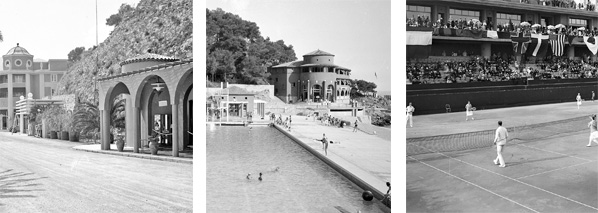
Monte-Carlo in the Roaring Twenties: 1919-1930
In the period between the two world wars, Monte Carlo established itself as a seaside resort and wanted to celebrate summer. New construction projects were carried out in Monaco to meet the demands of customers eager to soak up the summer sun. A coastal road was mapped out to the east, bordered by palm trees and small shops called ‘souks’. The bathhouse opened in July 1928.
In 1929, the Monte-Carlo Beach Hotel, whose style was reminiscent of luxury hotels in Florida, became a new and prestigious place to summer in Monaco.
Elsa Maxwell, the famous American journalist, pushed for the creation of a golden sandy beach. More reasonably, a magnificent swimming pool was finally built just above sea level.
The Beach Hotel secured Monaco's reputation as a summer resort through the quality of its services and the appeal of its memorable costume parties. Monaco offered summer holidaymakers a new seafront, and Larvotto beach welcomed its first bathers.
In 1928, tennis was given pride of place with the opening of the Monte Carlo Country Club. The club was opened in front of an audience of royalty: Gustaf V of Sweden, the Duke of Connaught, Prince Nicholas of Greece and Grand Duchess Elena and Grand Duke Andrei of Russia. This sport was given a high priority in Monaco because, since being exported from England in 1880, it became more and more popular every year.
Monte-Carlo and Art Deco: 1930-1939
The 30s was a profitable time for the construction of entertainment venues. In 1931, the colonial-style Sporting d’Eté was built on the seafront. It hosted the best shows of the season and offered spectators magical fireworks displays. The place du Casino gained a new show venue in 1932: the Sporting d’Hiver. The building, constructed on the site of the glass Palais des Beaux-Arts, rose spectacularly over the Boulingrins gardens and became a must for nights out in Monaco. The customers who frequented its gaming rooms were elite.
Run like an English club, the Sporting was only open to members. It was also home to a restaurant and nightclub whose customers applauded the ‘Girls of Monte Carlo’. Art deco was also celebrated at the Café de Paris, which was completely refurbished. The minarets and domes built at the beginning of the century were removed. Faience was replaced by frieze in line with the new art deco trend. The magic of Monte Carlo made celebrities forget the tragedies of this troubled period: the financial crisis of the 30s and the threat of war. The Hôtel de Paris was a real haven of tranquillity for its guests. Many of them were British: Lloyd George, Sir Winston Churchill, Sir Robert Vansittart and the Duke of Westminster all graced its corridors. Aga Khan, the Maharani of Kashmir, Prince Peter and Princess Violet of Montenegro, the Countess of La Rochefoucauld and René Blum were also among the hotel's famous guests. On 17 July 1943, in a moment of peace during the war, Radio Monte Carlo made its first broadcast from the Sporting d’Hiver. This event led to the birth of a superstar: Maurice Chevalier.
Monte-Carlo in the 50s: 1950-1959
The Allied victory in 1945 allowed Monte-Carlo to get its customers back. Sir Winston Churchill came back, honouring the promise he had been unable to keep because of his early return to England as a result of the tragic events. English customers gradually returned. The Duke and Duchess of Windsor, the Duke of Edinburgh and Lady Bateman, who lived at the Hôtel de Paris for the whole of winter, attended prestigious gala evenings in the 50s.
Edouard Herriot, Prince Peter of Yugoslavia and Queen Victoria Eugenie of Spain came to Monaco for a few days of relaxation and Charlie Chaplin returned after his stay in 1931 to present City Lights. The Hôtel de Paris also hosted the wedding of Errol Flynn with the actress Patrice Wymore in the Empire room in 1950.
It was attended by the big names in cinema: Rita Hayworth, Michèle Morgan and Gary Grant, to name a few.
The year 1952 saw the arrival in Monaco of the Greek shipowner, Onassis, who set up his oil company's offices in Marie Blanc’s old villa.
This period saw the beginning of business tourism as H.S.H. Prince Rainier III envisaged the development of international congresses. The hotel industry had to grow and adapt: four floors were added to the Rotunda at the Hôtel de Paris by the architects Bruyère and Chiappori.
The most famous event in the Principality during the second half of the 20th century was undeniably the marriage of H.S.H. Prince Rainier III and Grace Patricia Kelly, on 18 April 1956. Celebrations took place all over Monte-Carlo. Thanks to photographs distributed by the international press, all eyes were on a royal family celebrating the happiness of one of the most famous couples of the century.
Grand Balls: 1960-1969
In the early 1960s, the Café de Paris, always attentive to its customers’ wishes, underwent a number of significant changes. Henry Rigal installed a bowling alley, the latest trend, and opened a nightclub, the Scotch Club, with Scots-inspired decoration and, unexpectedly, an inverted chess board suspended from the ceiling.
Two years later, in line with the latest trend, the drugstore opened. In 1962, billiards tables disappeared and slot machines became the next revolution in games, their chrome exteriors shining brightly.
July 1960 saw the inauguration, at the Sporting d’été, of the Maona (a contraction of Maria and Onassis, the couple formed by Aristotle Onassis with the great singer Maria Callas) summer cabaret.
On 16 January 1961, the first Monte-Carlo Television Festival took place, presided over by Marcel Pagnol and created by Prince Rainier.
On 18 November 1961, work began on the Terre-Plein du Larvotto in front of the Sporting d’été.
As part of the events marking the centenary of Monte-Carlo, a Second Empire ball was held at the Casino on 27 May 1966, hosted by Monte-Carlo Société des Bains de Mer, with the assistance of Hélène Rochas and in the presence of T.S.H. the Prince and Princess of Monaco. Guests strolled around the Atrium, the Salle Garnier and on the terraces, reached by a double staircase built for the occasion by the production designer André Levasseur.
On 13 March 1968, to mark the reopening of the Salon de l’Europe at the Casino de Monte-Carlo after its restoration by André Levasseur, the Grand Bal Paré 1900 took place, attended by the royal couple. The following year, on 15 March, the Salle des Amériques was inaugurated with the Grand Bal des Têtes.
The late 20th century: 1970-1999
On 9 July 1971, Jimmy’z, a nightclub hosted by Régine, opened its doors at the Sporting d’été, and on 3 September 1973 Jimmy’z was launched for winter at the Café de Paris.
The Monte-Carlo Sporting Club (architects H Pothier & P Godin) was built on the new Terre-Plein du Larvotto and opened on 22 June 1974. Sammy Davis, the star of the evening, was unable to attend, but the show went on with Josephine Baker, Burt Bacharach and Desi Arnaz. Later that summer, on 9 August, Josephine was star of the show at the Monaco Red Cross gala.
That same year, Prince Rainier created the International Monte-Carlo Circus Festival, to offer an international perspective on the world of circus that was so dear to him.
On 17 December 1981, after a 26-year-gap, the lights came back on at the Théâtre des Beaux-arts, now the Théâtre Princesse Grace. Thanks to Princess Grace’s love of the performing arts, the theatre became a harmonious addition to the Salle Garnier and the Atrium, thus permitting the full revival of theatre in Monte-Carlo.
In 1985, the Ballets de Monte-Carlo company was formed at the wishes of H.S.H. Princess Caroline, who wanted to play a part in the tradition of dance in Monaco.
On 21 July 1988, the Café de Paris was restored to its former glory. The new café, the fifth to take this name, was inaugurated by Prince Rainier accompanied by members of the royal family.
Following the bombings of 1944, it wasn’t until April 1995 that a real thalassotherapy complex was to see the light of day after 2 years of construction.
Monte-Carlo since the year 2000
In 2004, the Hôtel Hermitage opened its extension designed by the architectural firm Joseph Iori in collaboration with Pierre-Yves Rochon.
2005 saw the inauguration of a new hotel, the Monte-Carlo Bay Hotel & Resort. This new complex covered 4 hectares of the Larvotto peninsula and included an 11-floor 4-star hotel overlooking the sea, gardens designed by the landscape architect Jean Mus containing Mediterranean and tropical species, a sand-bottomed lagoon that was the only one of its kind in Europe, an indoor swimming pool, a Cinq Mondes spa and even a helipad.
A real renaissance at the Monte-Carlo Beach. In 2009, the hotel regained its “riviera red” and was entirely redeveloped by architect India Madhavi. Visitors stepped directly from dry land to the pool and shore. The surrounding vegetation, designed by landscape gardener Jean Mus, soothed visitors as they breathed in the enchanting fragrances while they strolled around. The establishment was awarded 5 stars.
In 2013, the Monte-Carlo Société des Bains de Mer celebrated its 150th anniversary. A number of celebratory events took place throughout the year. These included Dîner sur l’herbe, designed by Alain Ducasse, organised on the Place du Casino on 5 July. The square was transformed into a Mediterranean garden and 500 guests attended this memorable event.
The following year, Monte-Carlo Société des Bains de Mer inaugurated its pop-up shops in the jardins des Boulingrins, 5 pavilions covering 2,700m² designed by the architect Richard Martinet.
2014 marked the beginning of the first stage of work at the Hôtel de Paris Monte-Carlo and on the future One Monte-Carlo.
On 1 July 2017, for one evening, the Place du Casino was transformed into a gigantic dance floor for the first F(ê)aites de la danse.
Early 2019 marked the end of the renovation and restructuring work at the Hôtel de Paris Monte-Carlo, with the inauguration of the Rainier III Suite in the presence of Prince Albert accompanied by his sister Princess Stephanie, and of work to build the One Monte-Carlo.
Despite the Covid-19 crisis, on 2 June 2020, Monte-Carlo Société des Bains de Mer opened the new Place du Casino in the presence of the royal couple and numerous other members of the royal family.
The following year, the company’s culinary offer was expanded with the opening of the COYA Monte-Carlo, of Yannick Alléno’s restaurant at the Hôtel Hermitage Monte-Carlo and, more recently, of the Lebanese restaurant Em Sherif at the Hôtel de Paris Monte-Carlo.
The story continues...
Monte-Carlo Société des Bains de Mer Contacts
Monte-Carlo Société des Bains de Mer
Place du Casino
MC 98000 Monaco
+377 98 06 60 00
Individual Hotel & Restaurant Reservations
T. +377 98 06 25 25
F. +377 98 06 26 26
Email: resort@sbm.mc
Group Hotel & Restauration Reservations
T. +377 98 06 17 17
F. +377 98 06 59 56
Email: groupes@sbm.mc
Website: montecarlomeeting.com
Open daily from 10am to 7pm and until 8pm in the summer.

